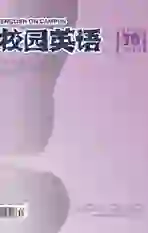On the E—C Translation of the Subtitle of Miranda from the Perspective of Reception Aesthetic Theory
2018-09-08ZhuXinyue
Zhu Xinyue
【Abstract】Based on the subtitle translation of Miranda, the author will analyze what methods should be adopted for fulfilling the audiences horizon of expectations from the perspective of reception aesthetic theory. It is found that using Chinese four-character structures, Chinese proverbs, Chinese dialects, Chinese proverbs and cyber-language can fulfill the horizon of expectations of the audience.
【Key words】subtitle translation; reception aesthetic theory; Miranda; horizon of expectations
【作者簡介】Zhu Xinyue, Lanzhou University, School for Foreign Languages and Literature.
1. Introduction
Miranda, a very successful TV program has gained its popularity on the internet. This paper tries to analyze the subtitle translation of Miranda from the perspective of reception aesthetic theory. It is found that using Chinese four-character structures, Chinese proverbs, Chinese dialects, Chinese proverbs and cyber-language can fulfill the horizon of expectations of the audience.
2. Subtitle Translation and Reception Aesthetic Theory
2.1 Subtitle Translation
As for subtitling, Nedergaard-Larsen regarded it as “a special type of language transfer: a written, condensed translation of a predominantly spoken original.” (Nedergaard-Larsen, 1993)
Li Yunxing proposes two main factors that constrain subtitle translation are time and space. As for time constrain, the language-image and subtitle-voice synchornization are required. Space constrain means that the proprotion of subtitle on the screen should not too because the space of the screen is limited. (Li Yunxing, 2001)
2.2 Reception Aesthetic Theory
Reception aesthetics theory is mainly a theory of literary criticism. As for the representatives of the Reception Aesthetics theory, Jauss and Iser are forerunners.
According to Jauss, the understanding of a text depends on the reader, and different readers will interpret the text from different perspectives. (Jauss, 1978) Iser believed that scholars should pay more attention to the text-reader relationship.
“Horizon of Expectations” is a key concept of reception aesthetics theory introduced by Jauss which means readers have their own experience and their own conditions, so they will take a creative approach to the works.
3. Fulfill the Horizon of Expectations of the Audience
3.1 The Application of Chinese Four-Character Structures
Chinese four-character structures are an indispensable part of Chinese language. With the features of conciseness, symmetry and vividness, they can express unlimited meanings with limited words.
Example1:
Miranda: Do you know, this really could be my thing.
對我来说,就是小菜一碟啊。
The literal meaning of “my thing” is “我的事情”. However, what Miranda wants to express is that she is good at this thing with ambitious tone. Thus, the Chinese four-character “小菜一碟” is a proper translation.
3.2 The Application of Chinese Proverbs
In Miranda, the author employs a lot of Chinese proverbs so as to fulfill the directed expectation of the audience. Chinese people are quite familiar with these proverbs as they are created by diligent Chinese people in their daily life.
Example2:
Miranda: Go me, go me, go me! How did this happen? A proper job!
前进,前进,前进进!天上掉馅饼了吗?一份体面的工作!
“天上掉馅饼” expresses Mirandas surprise when she gets a good job. It is really proper after all it is difficult for Miranda who always behaves awkward in public to find a proper job especially a good job.
3.3 The Application of Chinese Dialects
China covers a large territory and has many nationalities, hence a variety of dialects appear. Dialects can always create a funny atmosphere.
Example3:Miranda: I do like, I do like very much!
俺乐意,俺乐意的不得了!
In the example3, the translator employs the Dongbei dialect “俺” instead of “我” which can fulfill peoples directed expectation. The adoption of regional expressions makes the dialogue more natural and smooth.
4. Conclusion
This paper finds that through using Chinese four-character structures, proverbs, dialects and cyber-language the horizon of expectations of the audience can be fulfilled. In addition, the translator should pay more attention to the relationship between the original text and the audience and put the audience in the leading position.
References:
[1]Jauss,Hans Robert.Toward an Aesthetic of Reception[M].Mirrneapolis: University of Minesoda Press,1989.
